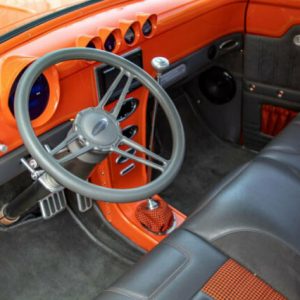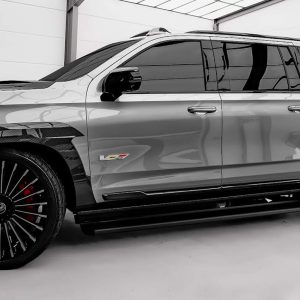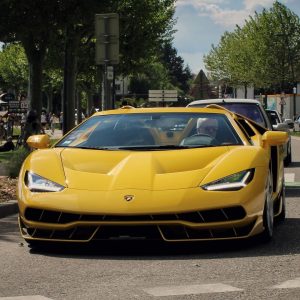The Crosstrek is arguably the most Subaru of all the Subarus.

It’s a rare pleasure to meet someone who knows exactly who they are but isn’t obnoxious about it. The 2.5-liter 2024 Subaru Crosstrek is that person. It’s the most Subaru of Subarus, attracting the brand’s youngest and most outdoorsy customers, and it’s coming soon to a trailhead or organic food co-op parking lot near you. The Northeastern states were the first U.S. territories annexed by the brand in the Great All-Wheel-Drive Battle of 1996™, so I headed up to Woodstock, New York—100 miles and one enormous vibe shift north of Manhattan—to sample the Sport and Limited trims of Subaru’s latest lifted hatchback on- and off-road. While it still won’t win any races, the Crosstrek 2.5L is a more competent, comfortable, and all-around enjoyable car than ever, with just enough Subaru quirk thrown in to keep the loyalists happy.
2024 Subaru Crosstrek 2.5 Specs
What’s a Sport, Anyway?
Now in its 12th year and third generation, the 2024 Crosstrek comes in four trim levels: Base, Premium, Sport, and Limited. The Base and Premium models are built in Japan and rock a 2.0-liter flat-four making 152 horsepower. We’ve already driven those, which you can read about here. This review covers the top two trims, which are built exclusively for North American markets in the brand’s Lafayette, Indiana plant and rock a bigger 2.5-liter flat-four engine. All Crosstreks come standard with Subaru’s updated EyeSight driver assistance tech, adaptive cruise control, and LED steering responsive headlights that track the front wheels like the proverbial cat and string.
In addition to the bigger 182-horse motor, stepping up to a Sport ($28,990) gets you dual-function X-Mode off-roading software with hill descent control, a wireless phone charger under the touchscreen, and an appearance package that adds 18-inch wheels inspired by bicycle gears and yellow splashes on the front and rear bumpers as well as on the rockers. It looks pretty slick, especially paired with the new Alpine Green drab. Inside, you get pleasantly grippy grey cloth seats with yellow accents to match the outside. The loaded Limited ($30,985) adds blind spot detection, automatic emergency steering and reverse braking, leather seats, and an optional Harmon Kardon sound system with genuinely impressive bass that will shake the place when you’re vibing out to SiriusXM Chill.

My one gripe with the trim packages is not being able to order the premium audio system on the Sport trim. Subaru says the average Crosstrek Sport customer is five years younger than Crosstrek buyers on the whole, and as a 26-year-old who hikes, bikes, and is squarely within their demographic, I can’t understand why they think we don’t want booming bass. Complexity is the enemy of profits, and I suspect Subaru wanted to avoid cannibalizing Limited sales, but given the different aesthetics and buyers, it feels like a missed opportunity.
Behind the Wheel
Getting behind the wheel of the Crosstrek, my first thought was that everything made sense. Front, side, and rear visibility are excellent, and the admittedly large C-pillars are broken up by little windows. The extra glass by the side mirrors remains a thoughtful touch. These are the details that matter, and Subaru says its customers are still the look-over-your-shoulder type. The controls are intuitive, and it’s a car nearly anyone can hop in and feel comfortable with right away. At six-foot-two, I didn’t have any issues with headroom or rear legroom.
For Premium models and up, Subaru grafted an 11.6-inch tablet onto the Crosstrek’s center stack, but thankfully there are chunky buttons and knobs on either side of it that control temperature, volume, track, and defrost functions. Fan speed is touchscreen-only, but with the fan set to auto, bumping the temperature buttons up and down triggers an appropriately quick response. Controls for the heated front seats—toastier than ever, according to Subaru—are located on the center console behind the shifter, as is tradition. To any automaker who thinks it’s OK to bury defrost and heated seat controls in a touchscreen menu, I say don’t mess with me before eight o’clock in the morning. The conveniently-placed wireless charge pad below the screen makes wireless Apple CarPlay a breeze.

Flinging the Crosstrek up winding country roads and two-lane highways was a pleasant surprise. The car felt much more stable than I’d remembered, owing in part to the 2024 model’s increased chassis rigidity and new dual-pinion steering system—derived from the WRX performance sedan. Initial turn-in and steering feel deliver a satisfying build in resistance, and the Crosstrek was surefooted through sweepers, over mid-corner bumps, and in transitions from one corner to another. There’s less body roll than I expected, too, given its ground clearance.
As part of its overhaul, Subaru focused on improving the Crosstrek’s road manners and overall comfort to reduce driving fatigue. Central to that are a redesigned seat with new hip and shoulder support, and additional padding in the headliner to reduce sound reverberation. As far as I can tell, it’s worked. I recall a four-hour road trip in a friend’s 2016 Crosstrek that left me cramped, exhausted, and with intermittent sciatica down my left leg. After seven hours in the 2024 model, I felt nearly as good as new. This thing is seriously quiet at highway speeds with the windows up, and rolling them down doesn’t produce any of the buffeting common to newer cars. There’s just a lack of perceptible NVH from the road or the powertrain that’s very soothing.
All right, let’s talk about the engine. I’ll be the millionth person to point out how much fun this car would be with the WRX’s new 2.4-liter, 271-hp turbo-four. Subaru themselves seem to acknowledge this, as they’ll sell you an STI starter button as a $250 accessory, but that’s likely as close as we’re getting for now. It’s not that the 2.5 is bad—it’s energetic around town, and at half-throttle, its 178 lb-ft of torque and CVT mosey along without shouting for your attention. If you put your foot down to merge or pass they’ll oblige, but it’s far from effortless. Power is adequate for most drivers, but especially given the chassis improvements, there’s room for a hot rod. The WRX motor would push the Crosstrek’s price into the mid-$30Ks at least, but I can’t help but think it’d be a return to proper WRX hatchback form.

Where the Pavement Ends
After some miles on the road, it was time to hit the trails. Subaru had prepared a pretty impressive course up and down a ski mountain, and it had rained six inches in the two days leading up to our drive. You know what that means: mud. I put Subaru’s X-Mode in its most advanced setting, deep snow/mud, which allows more wheel slip than the single snow/dirt setting that’s standard on the 2.0-liter cars. The Crosstrek scrabbled up rocky inclines like a mountain goat or Kate Bush, and its hill descent control kept things civilized by holding speed on the way down. I quickly found the street tires’ limit in deep mud, but thanks to the Crosstrek’s ground clearance and plastic cladding, I could just back up, climb over some small rocks, and try a different line. That’s the advantage to off-roading a small car like this as opposed to a more ponderous SUV; you can pick your lines as opposed to being stuck to one path. The stellar visibility was a boon here too, as I could identify obstacles before they became problems.
Street tires and the lack of a skid plate are the Crosstrek’s main limitations off-road—both of which the upcoming Wilderness model will remedy. I can’t wait to try that one out, but this is more than enough capability for most folks looking to access a campsite or drive some fire roads.

Playing to a Home Crowd
There are many great small cars and crossovers these days. The Mazda CX-30 offers an available turbo engine, and the Honda HR-V is a few bucks cheaper and has a smidge more storage space. Heck, if you have no delusions of ever leaving the pavement, the normal Civic and Corolla hatchbacks are excellent commuters, too. But I suspect Crosstrek buyers aren’t buying it because it beats the other cars on paper. They’re buying it because they want a Subaru, and it’s the most on-brand car it makes today. That’s why it’s the company’s bestseller.
Walking around Woodstock, I saw Crosstreks everywhere. Same with the streets around my neighborhood back in Brooklyn. What’s important is that this Crosstrek is a better one, and in that, it succeeds. It’s more comfortable and more fun to drive, and it hasn’t abandoned no-nonsense controls at the altar of the touchscreen. It’s a car that fits into your life rather than the other way around, and I suspect folks who buy them will be happy and keep them for a long time. And when they do decide to sell them, they’ll still be worth something. In a day and age when new cars are a more significant investment than ever, isn’t that all we can ask for?





